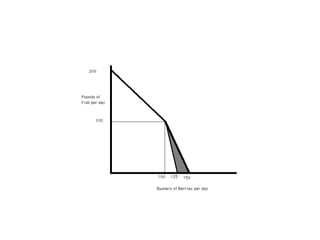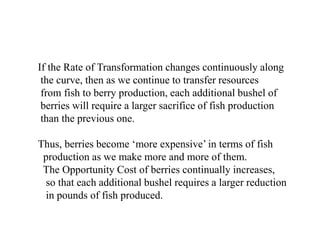ppc2.ppt
- 1. Economics 102: Introduction to Microeconomics Microeconomics: The study of how resources are allocated to various uses in society. Each society must answer the following three questions: Q1: What to produce? Q2: How to produce it? Q3: For whom do we produce it?
- 2. Economic Efficiency An economy, or economic process, is operating efficiently if it cannot make more of one good without making less of another.
- 3. Opportunity Cost The quantity of a good we must sacrifice to obtain one more unit of some other good.
- 4. Economic Models Models are simplified representations of reality, used to study and understand relationships in the real world. Models are, by nature, abstractions. The trick is choosing the correct level of abstraction. Most economic models are built with mathematics; graphs and equations.
- 5. Example: A simplified economy with limited resources for production. Resource: 100 workers who can pick berries or catch fish. 50 nets for collecting fish or berries.
- 6. The available technology: Workers [W]: 1 W => 1 bushel of berries per day or 1 W => 1 pound of fish per day Nets [N]: 1 N => 1/2 bushel of berries per day or 1 N => 2 pounds of fish per day
- 7. If all of our resources were used to produce fish: 100W*[1 pound per day/W]+50N*[2 bushel per day/N] => 200 pounds of fish per day If all of our resources were used to produce berries: 100W*[1 bushel per day/W]+50N*[1/2 bushel per day/N] => 125 bushels of berries per day
- 8. We would like to know all the possible combinations of fish and berries our society can produce. As we transfer resources from fish production to berry production, we will transfer the least productive fish producers first. In our example, this means we will transfer workers first. We will continue transferring workers until only workers are picking berries and all nets are being used to catch fish. If we want still more berries, we must shift nets from fish production to berry production. The terms of the trade-off of fish for berries will worsen.
- 9. When we transfer a worker from fish to berry production: We give up one pound of fish and we gain one additional bushel of berries. This implies that 1 pound of fish = one pound of berries. When we transfer a net from fish to berry production: We give up two pounds of fish and we gain 1/2 additional bushel of berries. This implies that 4 pounds of fish = 1 bushel of berries
- 10. Production Possibilities Curve (PPC): A graph of all economically efficient combinations of goods the society is able to produce. The changes in slope in the diagram tell us how the rate of exchange, or rater of transformation of goods, between fish and berries changes as we continue to transfer resources from one product to the other. The Rate of Transformation on the PPC is the rate of economically efficient exchange; it tells us the Opportunity Cost of one good in terms of another.
- 12. Rate of Transformation: [Change in pounds of fish per day]/[Change in bushels of berries per day] as we move along the PPC In other words, it is the slope of the PPC. On the upper part of the curve, the slope is -1 On the lower part of the curve, the slope is -4 The Rate of Transformation measures the amount of one good we must sacrifice to get one unit of the other, or, the Opportunity Cost. The Opportunity Cost of one bushel of berries is one pound of fish on the upper part of the curve, and 4 pounds of fish on the lower part of the curve.
- 13. The PPC will shift outward: ? If additional productive resources are made available. ? If current available resources become more productive. ? If more productive ways of combining resources are found.
- 14. Suppose our technology changes so that Nets become more productive than they were previously. The new technology is: 1 N => 1 bushel of berries per day [instead of 1/2 bushel/day or 1 N => 2 pounds of fish per day [same as before]
- 16. If the Rate of Transformation changes continuously along the curve, then as we continue to transfer resources from fish to berry production, each additional bushel of berries will require a larger sacrifice of fish production than the previous one. Thus, berries become ˇ®more expensiveˇŻ in terms of fish production as we make more and more of them. The Opportunity Cost of berries continually increases, so that each additional bushel requires a larger reduction in pounds of fish produced.
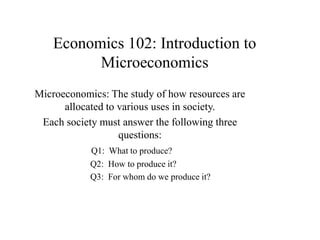
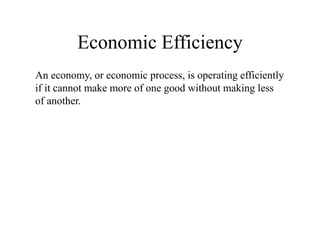

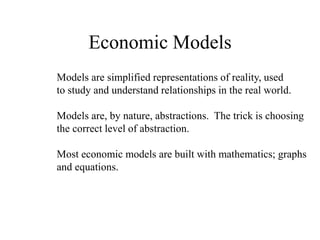
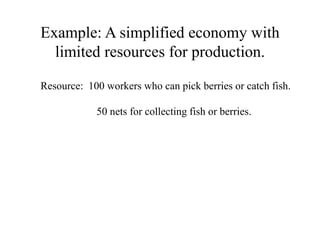
![The available technology:
Workers [W]: 1 W => 1 bushel of berries per day
or
1 W => 1 pound of fish per day
Nets [N]: 1 N => 1/2 bushel of berries per day
or
1 N => 2 pounds of fish per day](https://image.slidesharecdn.com/ppc2-221109060800-a15e48c0/85/ppc2-ppt-6-320.jpg)
![If all of our resources were used to produce fish:
100W*[1 pound per day/W]+50N*[2 bushel per day/N]
=> 200 pounds of fish per day
If all of our resources were used to produce berries:
100W*[1 bushel per day/W]+50N*[1/2 bushel per day/N]
=> 125 bushels of berries per day](https://image.slidesharecdn.com/ppc2-221109060800-a15e48c0/85/ppc2-ppt-7-320.jpg)
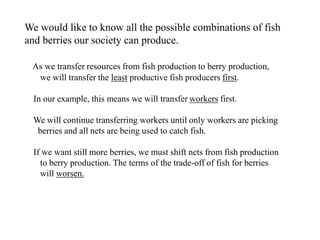


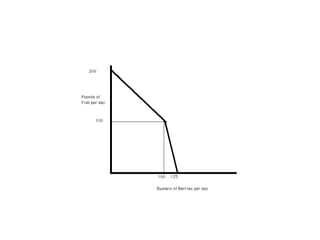
![Rate of Transformation:
[Change in pounds of fish per day]/[Change in bushels of berries per day]
as we move along the PPC
In other words, it is the slope of the PPC.
On the upper part of the curve, the slope is -1
On the lower part of the curve, the slope is -4
The Rate of Transformation measures the amount of one good we must
sacrifice to get one unit of the other, or, the Opportunity Cost.
The Opportunity Cost of one bushel of berries is one pound of fish on the
upper part of the curve, and 4 pounds of fish on the lower part of the curve.](https://image.slidesharecdn.com/ppc2-221109060800-a15e48c0/85/ppc2-ppt-12-320.jpg)
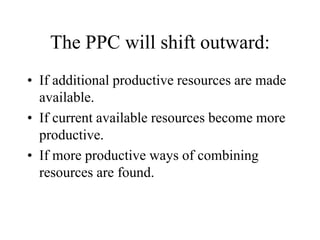
![Suppose our technology changes so that Nets become more
productive than they were previously.
The new technology is:
1 N => 1 bushel of berries per day [instead of 1/2 bushel/day
or
1 N => 2 pounds of fish per day [same as before]](https://image.slidesharecdn.com/ppc2-221109060800-a15e48c0/85/ppc2-ppt-14-320.jpg)
